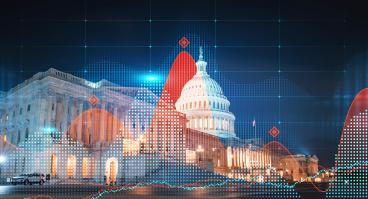U.S. Monetary Policy and the Debate About the Other Indian IT

Table of Contents
Author(s)
Russell Green
Former FellowIndia’s powerhouse information technology firms have nothing to do with the argument among Indian economists about the merits of IT. Rather, the Reserve Bank of India (RBI) recently proposed introducing an inflation targeting (IT) approach to monetary policy. For India, IT is a radical change that has generated a vigorous debate with frequent references to the U.S. experience. IT refers to a strategy where the central bank publicly announces an inflation target and then uses monetary policy nearly exclusively to steer the economy in that direction. The RBI has historically pursued many targets, including exchange rate stability, healthy economic growth, financial stability, minimizing the cost of financing the central government budget deficits and low inflation. All of these except inflation would fall to the wayside under IT. Inflation has not dropped much below 10 percent for the past eight years in India. Food prices have seen even higher inflation. As a single data point, four bananas in Bhim, Rajasthan cost 30 rupees today. Six years ago in Delhi, they would have cost eight rupees. In part, this is due to the fact that monetary policy has been used for many different purposes. Many view IT as the only way inflation can be brought back down. Others fear losing the flexibility to consider other factors in determining interest rates.
The Global Financial Crisis Challenged the IT Orthodoxy
Prior to the global financial crisis, mainstream economists recommended IT as the strategy all central banks should eventually aim to follow. The crisis challenged this orthodoxy because of a sense that IT contributed to the crisis in the U.S. and Europe. Most indices of inflation measure only consumer prices, so inflation-targeting central banks do not adjust interest rates in response to asset prices. In the period before the global financial crisis, the dramatic increase in Chinese production capacity (a large, positive supply shock) kept U.S. consumer prices low, but did not restrain asset prices. Strictly speaking, the U.S. does not follow an IT regime because the Fed also targets unemployment. But in reality, inflation is the primary target, so the U.S. subprime crisis provides fodder for the argument. Central banks like the RBI that attempted to deflate certain asset markets prior to the crisis (and many more that did not) experienced less of a bubble and a milder crash. The other critical ingredient of the subprime crisis was heavy capital inflows that kept long-term interest rates low. Much of the pre-crisis inflows to the U.S. were insensitive to domestic fundamentals because they resulted from pegged exchange rate regimes in capital account surplus countries. It is not clear that the U.S. had any monetary policy tools suited to counteract the impact on long-term rates. Suffice it to say that the U.S. employed neither short-term policy rates nor foreign exchange market intervention for this purpose, both of which would have disrupted the Fed’s inflation fighting strategy.
Relevant for India?
Should India worry about the need to use monetary policy to address a similar combination of high-income growth and low inflation or large-scale capital inflows that are insensitive to domestic fundamentals? Revealing the punch line upfront: Either circumstance could occur, but monetary policy is not the best tool to respond. Former chairmen of the Federal Reserve Alan Greenspan and Ben Bernanke both felt monetary policy ill-suited for addressing asset prices. Should the Fed have risked deflation in 2005 in order to reign in subprime lending? Even in retrospect, the answer is not obvious. Prudential regulations for lenders, such as provisioning requirements and loan-to-value limits, provide more appropriate tools. Indeed, India won praise for having used pro-cyclical provisioning requirements prior to the crisis to limit overheating in real estate. Does India need to worry much about structurally low inflation? While it appears a laughable proposition today, optimistic scenarios of positive supply shocks cannot be ruled out. Domestically, the rosiest vision of the future includes major structural reforms that can unleash India’s great low-wage manufacturing potential. The major reforms of 1991 and the development of the business service outsourcing model culminated in fast growth and low inflation from 2000 to 2006. Even achieving modest shades of further reform could provide enough of a positive supply shock to repeat this experience. Externally, energy prices may yet surprise with a more widespread drop from the shale revolution. But with the Chinese labor force now shrinking, another potential source of a major, positive global supply shock remains elusive. Turning to large-scale capital inflows, in theory a floating exchange rate provides automatic stabilization of the external accounts, freeing monetary policy to focus on internal stabilization. In practice, exchange rates famously ignore the dictates of economic theory. By adding to exchange rate volatility, these flows add uncertainty to export-oriented industries. With large enough capital flows, bubbles can emerge despite proactive, countercyclical prudential measures. Capital flows have a way of concentrating in areas with loose regulation. Being divorced from fundamentals, they flatter both weak projects and unsustainable government spending. When they retreat, domestic financial institutions exposed to bubbles can collapse. As pointed out in Hélène Rey’s talk last year in Jackson Hole, capital flows to emerging markets reach such volumes and can move with such apparent disregard to local fundamentals that they force domestic monetary policy to respond, even with a floating exchange rate.
Stick With IT
Despite these pressures, central banks that have adopted IT have stayed with the strategy. Several have adopted IT since the crisis. In part, this reflects the assessment that monetary policy should not be the first-line response to the concerns discussed above. It also reflects that — except where enshrined in law — central banks always have the flexibility to make adjustments to address emergencies. Indian central bank governor Raghuram Rajan has promised that IT will not turn the RBI into “inflation nutters.” Instead, the IT countries appear to have decided that the two interrelated benefits of IT outweigh the risks. The first benefit is that a simple inflation target makes a central bank easily accountable for its actions. The second is that accountability gives the public confidence in their success. With well-anchored inflation expectations, the public will not create inflation in their contracts, wage negotiations and menu prices. In India’s case, both are needed. Inflation expectations have been running above 12 percent for several years now. To the extent that the RBI surveys of inflation expectations have meaning, they imply a real need to anchor public expectations at a lower rate. Past RBI efforts to use one instrument to solve multiple problems were doomed to fail. Further, it gave the RBI an out, as it could point to growth or public finance mandates to duck responsibility for high inflation. IT could also help the RBI establish greater independence, as it has no legal basis for its independence from the government. An explicit IT framework would provide cover for RBI inflation fighting when it displeases the government.
Defusing the Debate
In debating the merits of IT in India, the discussion has referenced the possibility that the Fed risks reinflating an asset bubble through low interest rates. In this sense, the Fed’s tapering policy moves in the opposite direction, lowering the risk of a bubble repetition and taking ammunition away from IT critics. Several weeks ago, Rajan complained publicly about U.S. monetary policy. The Fed, he asserted, ignores the impact of rising U.S. interest rates on other economies. He worried about the potential for capital flows to emerging market countries to reverse, pushing their exchange rates down and their interest rates up. Perhaps he should have included a footnote of thanks for helping strengthen his case for introducing IT in India.
(As an aside, the Fed does, of course, consider the global impact of their policies. They have an entire division of economists that focus on their international context. The potential for Congress to accuse them of deviating from their purely domestic mandate, however, prevents them from discussing international considerations in much depth.)
Russell A. Green, Ph.D., is the Will Clayton Fellow in International Economics at Rice University’s Baker Institute. Green spent four years in India, where he served as the U.S. Treasury Department’s first financial attaché to that country. His engagement in India primarily focused on financial market development, India’s macroeconomy and illicit finance, but included diverse topics such as cross-border tax evasion and financing global climate change activities.
This material may be quoted or reproduced without prior permission, provided appropriate credit is given to the author and Rice University’s Baker Institute for Public Policy. The views expressed herein are those of the individual author(s), and do not necessarily represent the views of Rice University’s Baker Institute for Public Policy.


